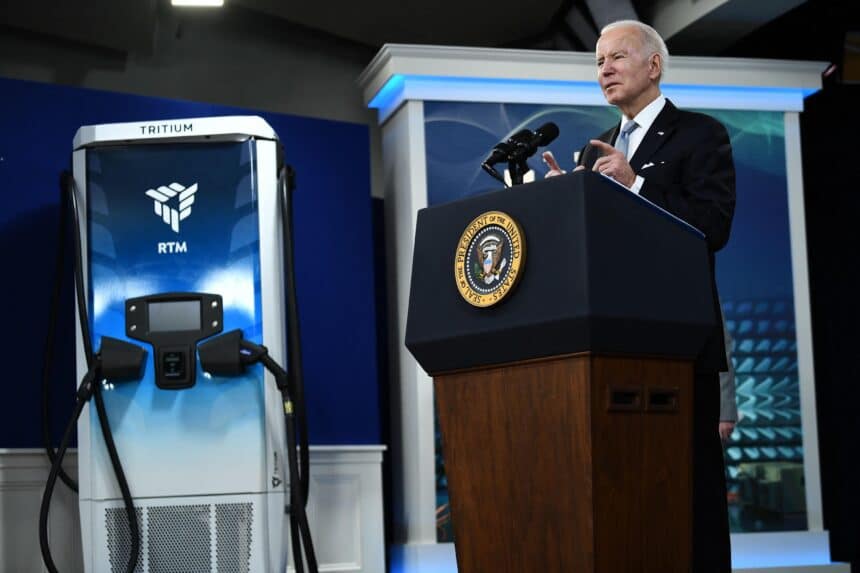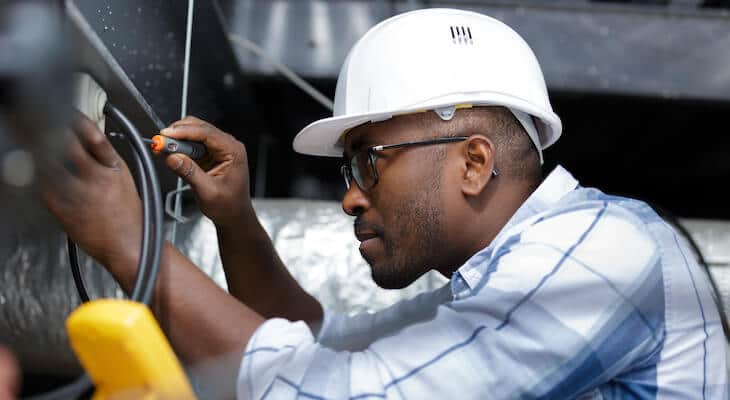Electrification Is Driving Our Economy In The Right Direction
The global market continues to shift steadily towards electric vehicles (EVs), which are becoming a major boon for America’s economy. EVs have tremendous potential to lower carbon pollution, help clean our air, and the industry is poised to create tens of thousands of US jobs. Today, the largest car manufacturers are committing over $300+ Billion to the production of EVs to support the growing demand for EVs. California and 14 other states have made zero-emissions commitments, further driving the demand and adoption of EVs. The U.S. government is actively taking steps to ensure that America leads in EV manufacturing, innovation, infrastructure, and deployment.

The US Departments of Transportation and Energy recently announced that nearly $5 billion is earmarked for a national electric vehicle charging network under the new National Electric Vehicle Infrastructure (NEVI) Formula Program established by President Joe Biden’s Bipartisan Infrastructure Law. US Transportation Secretary Pete Buttigieg said, “The President’s Bipartisan Infrastructure Law will help us win the EV race by working with states, labor, and the private sector to deploy a historic nationwide charging network that will make EV charging accessible for more Americans.”
Under the Democratic plan, a current $7,500 tax credit for the purchase of a new electric vehicle would rise as high as $12,500. An extra $4,500 would apply to vehicles assembled at unionized factories in the United States. Consumers would receive the final $500 if their vehicle had a U.S.-made battery. EV adoption is set to explode over the coming years and the US government is ensuring that we create lucrative jobs, expand our manufacturing ability, and make electric vehicles more affordable for families.

Infrastructure Helps Drive The Demand for Electric Vehicles
Federal and state incentives are accelerating our domestic EV industry, reinvigorating battery manufacturing and the automotive sector. Consumer incentives, transit and school bus incentives, and tax credits for zero-emission vehicles will bolster the electric vehicle manufacturing space in the country. In addition, cities and states across the nation now commonly set building and parking ordinances that require a minimum number of EV charging spaces. For instance, Orlando recently passed one such ordinance mandating that 10% of parking spaces at every commercial and industrial establishment and 20% of those at hotels and multi-residential lots provide EV charging services.
EV charging building code requirements exist in Arizona, California, Washington, Georgia, Hawaii, Massachusetts, New York, Oregon, Florida, and Utah. Infrastructure will help consumers overcome range anxiety and a nationwide charging network is needed to accelerate EV adoption. With $5 Billion in funding from the White House going to states to build out a nationwide fast charging network, EV growth is set to explode creating exciting job opportunities.
Electric vehicles require robust infrastructure that can supply sufficient charging solutions. Building the charging infrastructure network will minimize global warming pollution and employ numerous Americans. For example, charging infrastructure required to meet California’s EV goals could easily support 71,000 job-years over the next ten years. The take-away? Electrifying transportation translates into more jobs. With that said, we still need deliberate policies that guarantee job quality and accessible channels for priority communities. Highlighted below are some examples of exciting job creation in the EV industry.
General Motors EV Plant Expansions
In Spring Hill, Tennessee, General Motors is expanding its battery-building base. The company is working on its second plant for EV battery manufacturing that will create at least 1,300 new jobs. The GM team indicated that this step would transform the company as it focuses solely on electric vehicles.
The new factory will supply the nearby assembly plant. Besides, the move will help in accelerating EV adoption. Union members in the area are keen on maintaining their working relationship with General Motors as they transition to electric vehicles. The auto company focuses on creating good-paying union jobs as it moves into the EV space in full throttle.
General Motors also has a significant trail in Michigan, where it is setting up new EV plants. The company made headlines as it shifted from internal combustion production to battery electric vehicles. GM recently announced that it will invest $7 billion to achieve a production capacity of 1 million EVs by the end of 2025.
Part of this massive investment will go towards retooling the Orion, Michigan plant in a bid to ramp up production. At the moment, the plant focuses on Silverado and Sierra EV production. GM’s President indicated that the company intends to save time and money by utilizing existing facilities for its new project. Besides the 1,000 people already working at Orion, GM wants to create 2350 new jobs in this plant.
GM is also boosting its partnership with LG Energy Systems thanks to the $2.6 billion of investments it is setting aside to create a factory for the Ultium Cells LLC joint venture. The plant will have a capacity of 50 GWh that can support the production of 400,000 EVs per year. Once production kicks off, the plant will have close to 1700 employees.
Electric-Vehicle Assembly Plants Keep Growing
Rivian, an electric vehicle startup, recently launched the R1T truck and is working on a second factory in Atlanta, Georgia. Company projections indicate that the new plant will create 7500 jobs while assembling 400,000 EVs per year.
The electric vehicle startup debuted on the stock market and achieved the largest IPO since Facebook. Such high returns highlight the tremendous value in driving electric. Rivian mentioned that the carbon-conscious plant would form community engagement and develop workforce-training programs in the region. The company also intends to hold multiple town hall events to interact and understand the surrounding community’s needs.
Production in the new Georgia plant will potentially begin in 2024. Besides, Rivian is also working on upgrading its original plant in Illinois. The Illinois plant expects to hire an additional 1000 employees as it continues its rapid growth.
Tritium Joins The Budding US EV Market
Australian charging station manufacturer, Tritium has also joined the US EV market. The company has set in motion six production lines in Tennessee that will manufacture close to 10,000 DC chargers per year. This ramped up production should create 500 more jobs in the region.
The production facility can potentially increase production to 30,000 units annually at full capacity. The company is banking on hard-working Tennessee residents to boost its production. Recently, the company joined the Nasdaq stock market and intended to generate enough capital to expand its manufacturing facilities.
Canoo Inc Moves To Arkansas
Canoo Inc., a California electric vehicle company, is already leading the way in terms of job creation. The startup is moving its headquarters to Bentonville, Arkansas and intends to create at least 545 jobs in the area. Besides, the company has also set its sights on Oklahoma to create R&D and software centers. These projects will potentially create more than 700 jobs. The company is also creating a production facility that will create 2,000 jobs. Investments in these facilities will speed up the development of in-demand delivery vehicles.

Electric Vehicle Production Is Boosting Economy
A recent Economic Policy Institute (EPI) report expects that the shift to all-electric vehicles could create over 150,000 US jobs by 2030. The report concluded that it would take government subsidies focused on developing a domestic supply chain and increasing demand for U.S.-made vehicles for this level of job creation to become a reality. It found that without additional government investment, the industry could lose about 75,000 jobs by 2030, the year by which Mr. Biden wants half the new vehicles sold in the country to be electric. Conversely, the report said, if government subsidies were targeted to increase the portion of electric vehicle components that are manufactured domestically, and to increase the market share of U.S.-made vehicles, the industry could add 150,000 jobs by the end of the decade. With all this in mind, we are already seeing the Federal government showing signs of support with recent investments that help to ensure the charging station infrastructure is there to sustain the growing number of EVs on the road. Democrats are also discussing subsidies to encourage manufacturers to set up new factories or upgrade old ones. With so many market drivers behind the shift to EVs, one thing is for sure, the EV industry has the potential of boosting the US economy to new heights.
About the Author
Robb Monkman is a mission-driven entrepreneur who is passionate about making the world a better place. Robb is a serial entrepreneur with experience launching multiple hardware and software products at early-stage companies. Robb is an active angel investor and advisor helping companies that are making a positive impact in clean energy, electrification, and IoT.
Written by Robb Monkman
